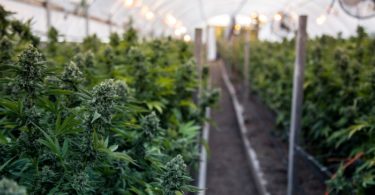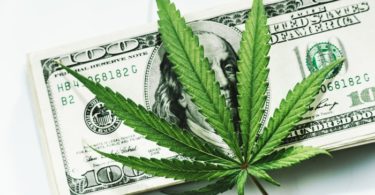For decades, the cannabis industry has been considered taboo. However, that changed in 2018. The passage of the Cannabis Act in Canada, and the ending of nine decades of recreational marijuana prohibition in October, paved the way for billions of dollars in added annual sales for the legal pot industry, as well as legitimized the cannabis business model.
This normalization of marijuana has led to a number of brand-name companies taking the plunge, so to speak. Molson Coors Brewing has partnered with Quebec-based grower HEXO, and Anheuser-Busch InBev formed a joint venture with Canadian grower Tilray, to research and develop cannabis-infused beverages. Meanwhile, tobacco giant Altria, the company behind the premium Marlboro brand in the U.S., is sinking $1.8 billion into Cronos Group, which’ll be good enough for a 45% equity stake.

THE ELECTRIC MODEL S SEDAN IS WHAT REALLY PUT TESLA ON THE MAP. IMAGE SOURCE: TESLA.
Could Tesla “go green?”
Pretty much everywhere you look, corporate America is suddenly giving cannabis the time of day it never previously received. This leads to the question of which brand-name company might be next to dip its toes into the pond. While pure speculation on my part, that next great marijuana stock could be Tesla (NASDAQ:TSLA).
Tesla is, of course, best known for its line of innovative electric vehicles (EVs) that include its upscale Model S, more affordable Model 3, and its SUV, the Model X. Like most automakers, Tesla provides its customers with a bevy of options that can improve the driving range of their vehicle as well as its performance.
But Tesla is also unique in many ways. Namely, it’s the first new automaker to successfully introduce a line of mass-produced vehicles in more than 50 years. It’s also attempting to internalize a number of its EV production expenses via the construction of its gigafactory (now known as gigafactory 1) in Nevada. The multibillion-dollar project produces lithium-ion batteries for its EVs and aids in subassembly. Essentially, Tesla is also trying to revolutionize how vehicles are manufactured from start to finish.
Yet, there’s even more to Tesla. There’s its renewable energy operations and solutions, which includes its acquisition of SolarCity for $2.6 billion in November 2016, which provides residential and commercial lease options for solar panels. It also involves the company’s clean energy battery storage solutions for residents, enterprises, and utilities alike.

IMAGE SOURCE: GETTY IMAGES.
Tesla’s battery solutions may be a long-term answer for cannabis growers
So, what does any of this have to do with the marijuana industry? While it’d be fun to suggest that self-driving Tesla EVs are going to deliver cannabis to your driveway, that’s not the answer. Rather, Tesla’s battery solutions could spark a revolution for marijuana growers.
Tesla’s Powerwall and Powerpack, which are residential and commercial options, respectively, offer the ability to store kilowatt capacity for backup purposes, as well as for future use. Although cannabis plants don’t do well during blackouts, there really aren’t too many growers that would utilize these power storage solutions for the purpose of hedging against power loss. Instead, Powerwall for smaller operations, and Powerpack for larger grow sites, could be used for the storage of electricity.
Cannabis growing costs can be pretty exorbitant as a result of electricity and cooling system costs. The industry has traditionally relied on high-pressure sodium (HPS) lights for indoor grow sites. Though relatively cheap to buy, HPS lights generate a lot of heat, requiring the use of cooling systems, and they gobble up a lot of electricity. Between the cooling system and HPS bulb itself, growers typically have very high electric bills.
One possible way to cut these costs is by utilizing LED bulbs. This is one reason why I’ve previously suggested giving LED light and lighting system manufacturer Cree a closer look. Unfortunately, LED bulbs cost quite a bit more up front than HPS bulbs, and their yields aren’t as predictable as crops grown under HPS lighting. Mind you, this isn’t a knock against LED lights, so much as to suggest that the data just isn’t there, with most growers being unwilling to make the switch to LEDs until more is known about their yields relative to HPS bulbs.

IMAGE SOURCE: TESLA.
But a better solution is offered via Powerwall/Powerpack. Understanding that indoor weed growers need a lot of electricity for their plants, they could opt to purchase and store energy during non-peak hours and utilize this energy during peak hours, thereby hedging the difference between peak and non-peak rates as savings. To be clear, this may only save pennies on the dollar, but when we’re talking about a large indoor grow site, the aggregate savings could be substantial.
Tesla’s clean energy battery solutions could come in particularly handy in the Emerald Triangle, a region in Northern California known for producing more cannabis than anywhere else in the United States. With PG&E (NYSE:PCG) facing a likely bankruptcy filing in the coming days due to an estimated $30 billion in liabilities tied to wildfires in 2017 and 2018, it’s the utility’s customers that could suffer.
Following the bankruptcy of PG&E’s utility in 2001 (not the holding company that you can buy stock in), higher rates were legally passed along to consumers to help cover the company’s debts. Now, with massive liabilities at stake, PG&E’s 16 million customers, including cannabis growers, could be called on to pay even higher rates. Tesla’s clean energy solutions could help mitigate some of these higher costs for growers, hopefully preventing the price of legal weed from shooting so high in California that it pushes consumers back into black market channels.
Understandably, the scenarios I’ve provided above are circumstantial. There is no guarantee that pot growers utilize Tesla’s storage solutions in any notable way to impact Tesla’s operating results. However, rising electric rates and a more established cannabis industry do provide appropriate incentives for large-scale growers to consider Tesla’s green energy storage solutions as a viable means to save money and improve margins.
Could Tesla be the next great marijuana stock? It’s not out of the question.
More at Fool.com







Thanks again for the blog.Really looking forward to read more. Want more.